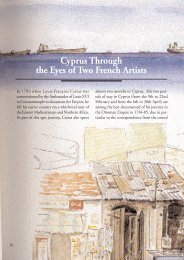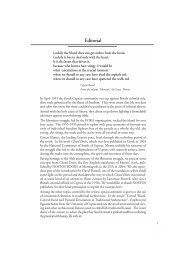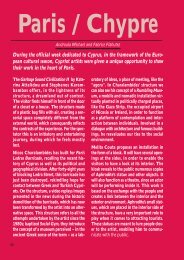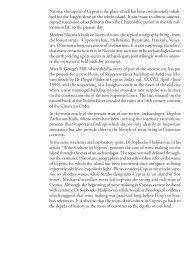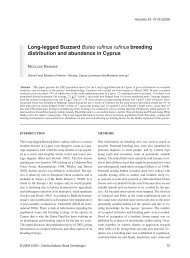Editorial
Editorial
Editorial
You also want an ePaper? Increase the reach of your titles
YUMPU automatically turns print PDFs into web optimized ePapers that Google loves.
1984, 231 no. 771). The olives, which<br />
were always counted, together<br />
with bread, constituted the everyday<br />
meal of the farmers, the workers,<br />
the craftsmen.<br />
In traditional households olives were prepared<br />
and preserved for domestic consumption in<br />
a variety of ways. Some of them are similar to<br />
those of antiquity. Black salted olives were<br />
preserved in koumnes (earthenware containers).<br />
A particular type of olive is preserved<br />
in brine and vinegar and is called kolymbati<br />
(swimming olive), a word deriving from the<br />
ancient name kolymvas elaia. According to the<br />
5th-century lexicographer Hesychios, this<br />
kind of preserved olive was called by the Cypriots<br />
vomvoia (see reference in Michaelides 1998,<br />
32). More common in Cyprus is the green<br />
tsakkisti (crushed) olive, the thlasti of the<br />
ancients. Cypriots also keep in vinegar and<br />
oil the adrouppa, a fleshy olive from which<br />
they do not get oil (Xioutas, A, 1984, 74).<br />
The most characteristic Cypriot olive is the<br />
tsakkisti (Fig. 5), which is prepared as follows:<br />
they crush lightly the green olives with a stone<br />
and cover them with water which is changed<br />
twice a day, until the bitterness has gone. Then<br />
they put the olives in bottles with brine and<br />
lemon juice. Before serving, they are prepared<br />
with finely chopped garlic, crushed coriander<br />
seeds, olive oil, thin slices of lemon and lemon<br />
juice (Evangelatou, 35-36).<br />
A very common Cypriot food with olives is<br />
the elioti or olive bread.<br />
It is prepared with dough (made of flour<br />
and water) in which black olives, dried<br />
mint, coarsely chopped fresh coriander leaves<br />
and onions are added. They knead all the<br />
ingredients together, shape the dough into<br />
Ladokouzin,<br />
glazed jug with<br />
a spout for serving<br />
olive oil. Kilani village,<br />
Limassol district.<br />
small round loaves and bake<br />
them in the oven (Farmakides 1983,<br />
302).<br />
The role of the olive was, and continues to<br />
be, especially important during fasting periods,<br />
which covered more than half the days<br />
of the year. It is considered, indeed, that the<br />
small quantity of oil which the very few olives<br />
in the daily diet contain does not break the<br />
fast and for this reason the consumption of<br />
olives is permitted on fasting days when olive<br />
oil is prohibited (for the fasting periods and<br />
the related foods see Egoumenidou and<br />
11





